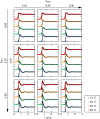A new look at effective interactions between microgel particles
- PMID: 30487527
- PMCID: PMC6262015
- DOI: 10.1038/s41467-018-07332-5
A new look at effective interactions between microgel particles
Abstract
Thermoresponsive microgels find widespread use as colloidal model systems, because their temperature-dependent size allows facile tuning of their volume fraction in situ. However, an interaction potential unifying their behavior across the entire phase diagram is sorely lacking. Here we investigate microgel suspensions in the fluid regime at different volume fractions and temperatures, and in the presence of another population of small microgels, combining confocal microscopy experiments and numerical simulations. We find that effective interactions between microgels are clearly temperature dependent. In addition, microgel mixtures possess an enhanced stability compared to hard colloid mixtures - a property not predicted by a simple Hertzian model. Based on numerical calculations we propose a multi-Hertzian model, which reproduces the experimental behavior for all studied conditions. Our findings highlight that effective interactions between microgels are much more complex than usually assumed, displaying a crucial dependence on temperature and on the internal core-corona architecture of the particles.
Conflict of interest statement
The authors declare no competing interests.
Figures






Similar articles
-
Viscoelasticity of dense suspensions of thermosensitive microgel mixtures undergoing colloidal gelation.Soft Matter. 2018 Feb 28;14(9):1596-1607. doi: 10.1039/c7sm02411h. Soft Matter. 2018. PMID: 29411837
-
Are thermoresponsive microgels model systems for concentrated colloidal suspensions? A rheology and small-angle neutron scattering study.Langmuir. 2004 Aug 17;20(17):7283-92. doi: 10.1021/la049518x. Langmuir. 2004. PMID: 15301516
-
Linear and nonlinear viscoelasticity of concentrated thermoresponsive microgel suspensions.J Colloid Interface Sci. 2021 Nov;601:886-898. doi: 10.1016/j.jcis.2021.05.111. Epub 2021 May 23. J Colloid Interface Sci. 2021. PMID: 34186277
-
3D Printable Poly(N-isopropylacrylamide) Microgel Suspensions with Temperature-Dependent Rheological Responses.ACS Appl Polym Mater. 2024 Mar 21;6(23):14095-14105. doi: 10.1021/acsapm.3c03230. eCollection 2024 Dec 13. ACS Appl Polym Mater. 2024. PMID: 39697841 Free PMC article. Review.
-
Synthetic and biopolymeric microgels: Review of similarities and difference in behaviour in bulk phases and at interfaces.Adv Colloid Interface Sci. 2023 Oct;320:102983. doi: 10.1016/j.cis.2023.102983. Epub 2023 Aug 15. Adv Colloid Interface Sci. 2023. PMID: 37690329 Review.
Cited by
-
In situ imaging of the three-dimensional shape of soft responsive particles at fluid interfaces by atomic force microscopy.Sci Adv. 2022 Nov 11;8(45):eabq2019. doi: 10.1126/sciadv.abq2019. Epub 2022 Nov 9. Sci Adv. 2022. PMID: 36351021 Free PMC article.
-
Numerical modelling of non-ionic microgels: an overview.Soft Matter. 2019 Feb 6;15(6):1108-1119. doi: 10.1039/c8sm02089b. Soft Matter. 2019. PMID: 30543246 Free PMC article. Review.
-
Phase behavior of silica-PNIPAm nanogels under high hydrostatic pressure.J Appl Crystallogr. 2025 May 12;58(Pt 3):919-926. doi: 10.1107/S1600576725003188. eCollection 2025 Jun 1. J Appl Crystallogr. 2025. PMID: 40475939 Free PMC article.
-
Controlling Kinetic Pathways in Demixing Microgel-Micelle Mixtures.Langmuir. 2023 Jan 9;39(3):1010-8. doi: 10.1021/acs.langmuir.2c02583. Online ahead of print. Langmuir. 2023. PMID: 36621908 Free PMC article.
-
On the role of softness in ionic microgel interactions.Soft Matter. 2021 Nov 17;17(44):10063-10072. doi: 10.1039/d1sm01222c. Soft Matter. 2021. PMID: 34714903 Free PMC article.
References
-
- Vlassopoulos D, Cloitre M. Tunable rheology of dense soft deformable colloids. Curr. Opin. Colloid In. 2014;19:561–574. doi: 10.1016/j.cocis.2014.09.007. - DOI
Publication types
Grants and funding
LinkOut - more resources
Full Text Sources

